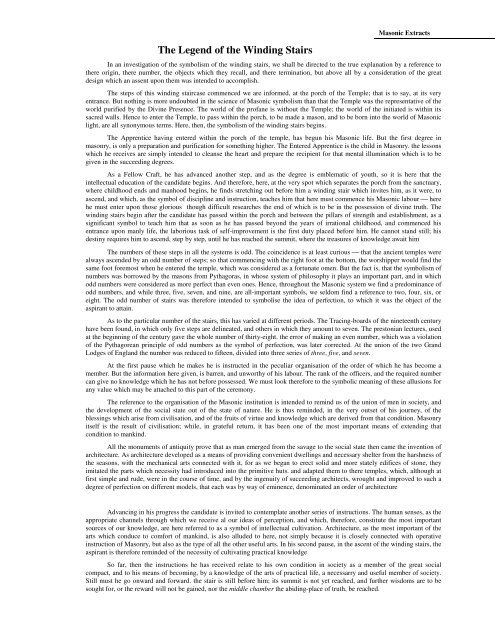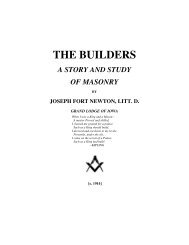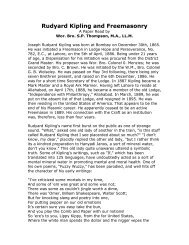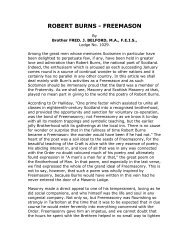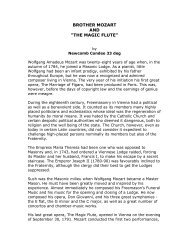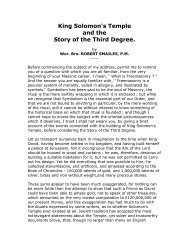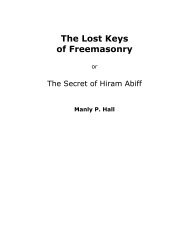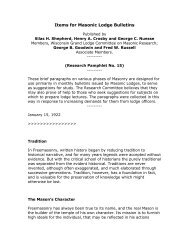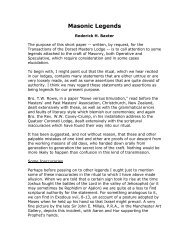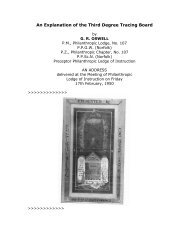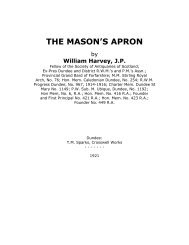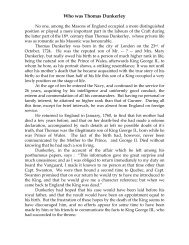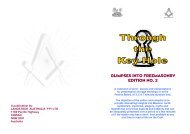The Legend of the Winding Stairs - Rose Croix
The Legend of the Winding Stairs - Rose Croix
The Legend of the Winding Stairs - Rose Croix
Create successful ePaper yourself
Turn your PDF publications into a flip-book with our unique Google optimized e-Paper software.
<strong>The</strong> <strong>Legend</strong> <strong>of</strong> <strong>the</strong> <strong>Winding</strong> <strong>Stairs</strong><br />
Masonic Extracts<br />
In an investigation <strong>of</strong> <strong>the</strong> symbolism <strong>of</strong> <strong>the</strong> winding stairs, we shall be directed to <strong>the</strong> true explanation by a reference to<br />
<strong>the</strong>re origin, <strong>the</strong>re number, <strong>the</strong> objects which <strong>the</strong>y recall, and <strong>the</strong>re termination, but above all by a consideration <strong>of</strong> <strong>the</strong> great<br />
design which an assent upon <strong>the</strong>m was intended to accomplish.<br />
<strong>The</strong> steps <strong>of</strong> this winding staircase commenced we are informed, at <strong>the</strong> porch <strong>of</strong> <strong>the</strong> Temple; that is to say, at its very<br />
entrance. But nothing is more undoubted in <strong>the</strong> science <strong>of</strong> Masonic symbolism than that <strong>the</strong> Temple was <strong>the</strong> representative <strong>of</strong> <strong>the</strong><br />
world purified by <strong>the</strong> Divine Presence. <strong>The</strong> world <strong>of</strong> <strong>the</strong> pr<strong>of</strong>ane is without <strong>the</strong> Temple; <strong>the</strong> world <strong>of</strong> <strong>the</strong> initiated is within its<br />
sacred walls. Hence to enter <strong>the</strong> Temple, to pass within <strong>the</strong> porch, to be made a mason, and to be born into <strong>the</strong> world <strong>of</strong> Masonic<br />
light, are all synonymous terms. Here, <strong>the</strong>n, <strong>the</strong> symbolism <strong>of</strong> <strong>the</strong> winding stairs begins.<br />
<strong>The</strong> Apprentice having entered within <strong>the</strong> porch <strong>of</strong> <strong>the</strong> temple, has begun his Masonic life. But <strong>the</strong> first degree in<br />
masonry, is only a preparation and purification for something higher. <strong>The</strong> Entered Apprentice is <strong>the</strong> child in Masonry. <strong>the</strong> lessons<br />
which he receives are simply intended to cleanse <strong>the</strong> heart and prepare <strong>the</strong> recipient for that mental illumination which is to be<br />
given in <strong>the</strong> succeeding degrees.<br />
As a Fellow Craft, he has advanced ano<strong>the</strong>r step, and as <strong>the</strong> degree is emblematic <strong>of</strong> youth, so it is here that <strong>the</strong><br />
intellectual education <strong>of</strong> <strong>the</strong> candidate begins. And <strong>the</strong>refore, here, at <strong>the</strong> very spot which separates <strong>the</strong> porch from <strong>the</strong> sanctuary,<br />
where childhood ends and manhood begins, he finds stretching out before him a winding stair which invites him, as it were, to<br />
ascend, and which, as <strong>the</strong> symbol <strong>of</strong> discipline and instruction, teaches him that here must commence his Masonic labour ⎯ here<br />
he must enter upon those glorious though difficult researches <strong>the</strong> end <strong>of</strong> which is to be in <strong>the</strong> possession <strong>of</strong> divine truth. <strong>The</strong><br />
winding stairs begin after <strong>the</strong> candidate has passed within <strong>the</strong> porch and between <strong>the</strong> pillars <strong>of</strong> strength and establishment, as a<br />
significant symbol to teach him that as soon as he has passed beyond <strong>the</strong> years <strong>of</strong> irrational childhood, and commenced his<br />
entrance upon manly life, <strong>the</strong> laborious task <strong>of</strong> self-improvement is <strong>the</strong> first duty placed before him. He cannot stand still; his<br />
destiny requires him to ascend, step by step, until he has reached <strong>the</strong> summit, where <strong>the</strong> treasures <strong>of</strong> knowledge await him<br />
<strong>The</strong> numbers <strong>of</strong> <strong>the</strong>se steps in all <strong>the</strong> systems is odd. <strong>The</strong> coincidence is at least curious ⎯ that <strong>the</strong> ancient temples were<br />
always ascended by an odd number <strong>of</strong> steps; so that commencing with <strong>the</strong> right foot at <strong>the</strong> bottom, <strong>the</strong> worshipper would find <strong>the</strong><br />
same foot foremost when he entered <strong>the</strong> temple, which was considered as a fortunate omen. But <strong>the</strong> fact is, that <strong>the</strong> symbolism <strong>of</strong><br />
numbers was borrowed by <strong>the</strong> masons from Pythagoras, in whose system <strong>of</strong> philosophy it plays an important part, and in which<br />
odd numbers were considered as more perfect than even ones. Hence, throughout <strong>the</strong> Masonic system we find a predominance <strong>of</strong><br />
odd numbers, and while three, five, seven, and nine, are all-important symbols, we seldom find a reference to two, four, six, or<br />
eight. <strong>The</strong> odd number <strong>of</strong> stairs was <strong>the</strong>refore intended to symbolise <strong>the</strong> idea <strong>of</strong> perfection, to which it was <strong>the</strong> object <strong>of</strong> <strong>the</strong><br />
aspirant to attain.<br />
As to <strong>the</strong> particular number <strong>of</strong> <strong>the</strong> stairs, this has varied at different periods. <strong>The</strong> Tracing-boards <strong>of</strong> <strong>the</strong> nineteenth century<br />
have been found, in which only five steps are delineated, and o<strong>the</strong>rs in which <strong>the</strong>y amount to seven. <strong>The</strong> prestonian lectures, used<br />
at <strong>the</strong> beginning <strong>of</strong> <strong>the</strong> century gave <strong>the</strong> whole number <strong>of</strong> thirty-eight. <strong>the</strong> error <strong>of</strong> making an even number, which was a violation<br />
<strong>of</strong> <strong>the</strong> Pythagorean principle <strong>of</strong> odd numbers as <strong>the</strong> symbol <strong>of</strong> perfection, was later corrected. At <strong>the</strong> union <strong>of</strong> <strong>the</strong> two Grand<br />
Lodges <strong>of</strong> England <strong>the</strong> number was reduced to fifteen, divided into three series <strong>of</strong> three, five, and seven.<br />
At <strong>the</strong> first pause which he makes he is instructed in <strong>the</strong> peculiar organisation <strong>of</strong> <strong>the</strong> order <strong>of</strong> which he has become a<br />
member. But <strong>the</strong> information here given, is barren, and unworthy <strong>of</strong> his labour. <strong>The</strong> rank <strong>of</strong> <strong>the</strong> <strong>of</strong>ficers, and <strong>the</strong> required number<br />
can give no knowledge which he has not before possessed. We must look <strong>the</strong>refore to <strong>the</strong> symbolic meaning <strong>of</strong> <strong>the</strong>se allusions for<br />
any value which may be attached to this part <strong>of</strong> <strong>the</strong> ceremony.<br />
<strong>The</strong> reference to <strong>the</strong> organisation <strong>of</strong> <strong>the</strong> Masonic institution is intended to remind us <strong>of</strong> <strong>the</strong> union <strong>of</strong> men in society, and<br />
<strong>the</strong> development <strong>of</strong> <strong>the</strong> social state out <strong>of</strong> <strong>the</strong> state <strong>of</strong> nature. He is thus reminded, in <strong>the</strong> very outset <strong>of</strong> his journey, <strong>of</strong> <strong>the</strong><br />
blessings which arise from civilisation, and <strong>of</strong> <strong>the</strong> fruits <strong>of</strong> virtue and knowledge which are derived from that condition. Masonry<br />
itself is <strong>the</strong> result <strong>of</strong> civilisation; while, in grateful return, it has been one <strong>of</strong> <strong>the</strong> most important means <strong>of</strong> extending that<br />
condition to mankind.<br />
All <strong>the</strong> monuments <strong>of</strong> antiquity prove that as man emerged from <strong>the</strong> savage to <strong>the</strong> social state <strong>the</strong>n came <strong>the</strong> invention <strong>of</strong><br />
architecture. As architecture developed as a means <strong>of</strong> providing convenient dwellings and necessary shelter from <strong>the</strong> harshness <strong>of</strong><br />
<strong>the</strong> seasons, with <strong>the</strong> mechanical arts connected with it, for as we began to erect solid and more stately edifices <strong>of</strong> stone, <strong>the</strong>y<br />
imitated <strong>the</strong> parts which necessity had introduced into <strong>the</strong> primitive huts. and adapted <strong>the</strong>m to <strong>the</strong>re temples, which, although at<br />
first simple and rude, were in <strong>the</strong> course <strong>of</strong> time, and by <strong>the</strong> ingenuity <strong>of</strong> succeeding architects, wrought and improved to such a<br />
degree <strong>of</strong> perfection on different models, that each was by way <strong>of</strong> eminence, denominated an order <strong>of</strong> architecture<br />
Advancing in his progress <strong>the</strong> candidate is invited to contemplate ano<strong>the</strong>r series <strong>of</strong> instructions. <strong>The</strong> human senses, as <strong>the</strong><br />
appropriate channels through which we receive al our ideas <strong>of</strong> perception, and which, <strong>the</strong>refore, constitute <strong>the</strong> most important<br />
sources <strong>of</strong> our knowledge, are here referred to as a symbol <strong>of</strong> intellectual cultivation. Architecture, as <strong>the</strong> most important <strong>of</strong> <strong>the</strong><br />
arts which conduce to comfort <strong>of</strong> mankind, is also alluded to here, not simply because it is closely connected with operative<br />
instruction <strong>of</strong> Masonry, but also as <strong>the</strong> type <strong>of</strong> all <strong>the</strong> o<strong>the</strong>r useful arts. In his second pause, in <strong>the</strong> ascent <strong>of</strong> <strong>the</strong> winding stairs, <strong>the</strong><br />
aspirant is <strong>the</strong>refore reminded <strong>of</strong> <strong>the</strong> necessity <strong>of</strong> cultivating practical knowledge<br />
So far, <strong>the</strong>n <strong>the</strong> instructions he has received relate to his own condition in society as a member <strong>of</strong> <strong>the</strong> great social<br />
compact, and to his means <strong>of</strong> becoming, by a knowledge <strong>of</strong> <strong>the</strong> arts <strong>of</strong> practical life, a necessarry and useful member <strong>of</strong> society.<br />
Still must he go onward and forward. <strong>the</strong> stair is still before him; its summit is not yet reached, and fur<strong>the</strong>r wisdoms are to be<br />
sought for, or <strong>the</strong> reward will not be gained, nor <strong>the</strong> middle chamber <strong>the</strong> abiding-place <strong>of</strong> truth, be reached.
Masonic Extracts<br />
In his third pause, he <strong>the</strong>refore arrives at that point in which <strong>the</strong> whole circle <strong>of</strong> human science is to be<br />
explained. Symbols, we know, are in <strong>the</strong>mselves arbitrary and <strong>of</strong> conventional signification, and <strong>the</strong> complete<br />
circle <strong>of</strong> human science might have been as well symbolesed by any o<strong>the</strong>r sign or series <strong>of</strong> doctrines as by <strong>the</strong> seven liberal arts<br />
and sciences. But Masony is an institution <strong>of</strong> olden time; and this selection <strong>of</strong> <strong>the</strong> liberal arts and sciences as a symbol <strong>of</strong> <strong>the</strong><br />
completion <strong>of</strong> human learningis one <strong>of</strong> <strong>the</strong> most pregnant evidences that we have <strong>of</strong> its antiquity.<br />
In <strong>the</strong> seventh century, and for a long time afterwards, <strong>the</strong> circle <strong>of</strong> instruction to which all <strong>the</strong> learning <strong>of</strong> <strong>the</strong> most<br />
eminent schools and most distinguished philosophers was confined, was limited to what were <strong>the</strong>n called <strong>the</strong> liberal arts and<br />
sciences, and consisted <strong>of</strong> two branches, <strong>the</strong> trivium and <strong>the</strong> quadrivium. <strong>The</strong> trivium included grammar, rhetoric, and logic; <strong>the</strong><br />
quadrivium comprehended arithmetic, geometry, music, and astronomy. <strong>The</strong>se seven arts were supposed to include universal<br />
knowledge. He who was master <strong>of</strong> <strong>the</strong>se was thought to have no need <strong>of</strong> a preceptor to explain any books or to solve any<br />
question which lay within <strong>the</strong> compass <strong>of</strong> human reason, <strong>the</strong> knowledge <strong>of</strong> <strong>the</strong> trivium having furnished him with <strong>the</strong> key to all<br />
language, and that <strong>of</strong> <strong>the</strong> quadrivium having opened to him <strong>the</strong> secret laws <strong>of</strong> nature.<br />
But we are not yet done. It will be remembered that a reward was promised for all this toilsome ascent <strong>of</strong> <strong>the</strong> winding<br />
stairs. Now, what are <strong>the</strong> wages <strong>of</strong> a Speculative Mason? Not money, nor corn, nor wine, nor oil. All <strong>the</strong>se are but symbols. His<br />
wages are truth, or <strong>the</strong> approximation to which it will be most appropriate to <strong>the</strong> degree into which he has been initiated. It is one<br />
<strong>of</strong> <strong>the</strong> most beautiful, but at <strong>the</strong> same time most abstruse, doctrines <strong>of</strong> <strong>the</strong> science <strong>of</strong> Masonic symbolism that <strong>the</strong> Mason is ever<br />
to be in search <strong>of</strong> truth, but is never to find it. This divine truth, <strong>the</strong> object <strong>of</strong> all his labours, is symbolised by <strong>the</strong> Word, for<br />
which we all know he can only obtain a substitute; and this is intended to teach <strong>the</strong> humiliating but necessary lesson that <strong>the</strong><br />
knowledge <strong>of</strong> nature, <strong>of</strong> God, and <strong>of</strong> man's relation to <strong>the</strong>m, which knowledge constitutes divine truth, can never be acquired in<br />
this life. Only at <strong>the</strong> end <strong>of</strong> this life shall he know <strong>the</strong> origin <strong>of</strong> life.<br />
<strong>The</strong> middle chamber is <strong>the</strong>refore symbolic <strong>of</strong> this life, where <strong>the</strong> symbol only <strong>of</strong> <strong>the</strong> Word can be given, where <strong>the</strong> truth is<br />
to be reached by approximation only, and yet where we are to learn that truth will consist in a perfect knowledge <strong>of</strong> <strong>the</strong><br />
G.G.O.T.U. This is <strong>the</strong> reward <strong>of</strong> <strong>the</strong> inquiring Mason; in this consist <strong>the</strong> wages <strong>of</strong> a Fellow Craft; he is directed to <strong>the</strong> truth, but<br />
he must travel far<strong>the</strong>r and ascend still higher to attain it.<br />
It is <strong>the</strong>n, as a symbol, and as a symbol only, that we must study this beautiful legend <strong>of</strong> <strong>the</strong> winding stairs. if we attempt<br />
to adopt it as a historical fact, <strong>the</strong> absurdity <strong>of</strong> its details stares us in <strong>the</strong> face, and wise men will wonder at our credulity. Its<br />
inventors had no desire to thus impose upon our folly; but <strong>of</strong>fering it to us as a great philosophical myth, <strong>the</strong>y did not for a<br />
moment suppose that we would pass over its sublime moral teachings to accept <strong>the</strong> allegory as a historical narrative without<br />
meaning, and wholly irreconcilable with <strong>the</strong> records <strong>of</strong> Scripture, and opposed by all <strong>the</strong> principles <strong>of</strong> probability. To suppose<br />
that eighty thousand craftsman were weekly paid in <strong>the</strong> narrow precincts <strong>of</strong> <strong>the</strong> Temple chambers, is simply to suppose an<br />
absurdity. But to believe that all this pictorial representation <strong>of</strong> an ascent by a winding staircase to <strong>the</strong> place where <strong>the</strong> wages <strong>of</strong><br />
labour were received, was an allegory to teach us <strong>the</strong> ascent <strong>of</strong> <strong>the</strong> mind from ignorance, through all <strong>the</strong> toils <strong>of</strong> study and <strong>the</strong><br />
difficulties <strong>of</strong> obtaining knowledge, receiving here a little and <strong>the</strong>re a little, adding something to <strong>the</strong> stock <strong>of</strong> our ideas at each<br />
step, until, in <strong>the</strong> middle chamber <strong>of</strong> life, ⎯ in <strong>the</strong> full fruition <strong>of</strong> manhood,⎯ <strong>the</strong> reward is attained, and <strong>the</strong> purified and<br />
elevated intellect is invested with <strong>the</strong> reward in <strong>the</strong> direction how to seek truth and knowledge; to believe this, is to believe and to<br />
know <strong>the</strong> true design <strong>of</strong> Speculative Masonry, <strong>the</strong> only design which makes it worthy <strong>of</strong> a good and wise man's study<br />
One step at a time.


